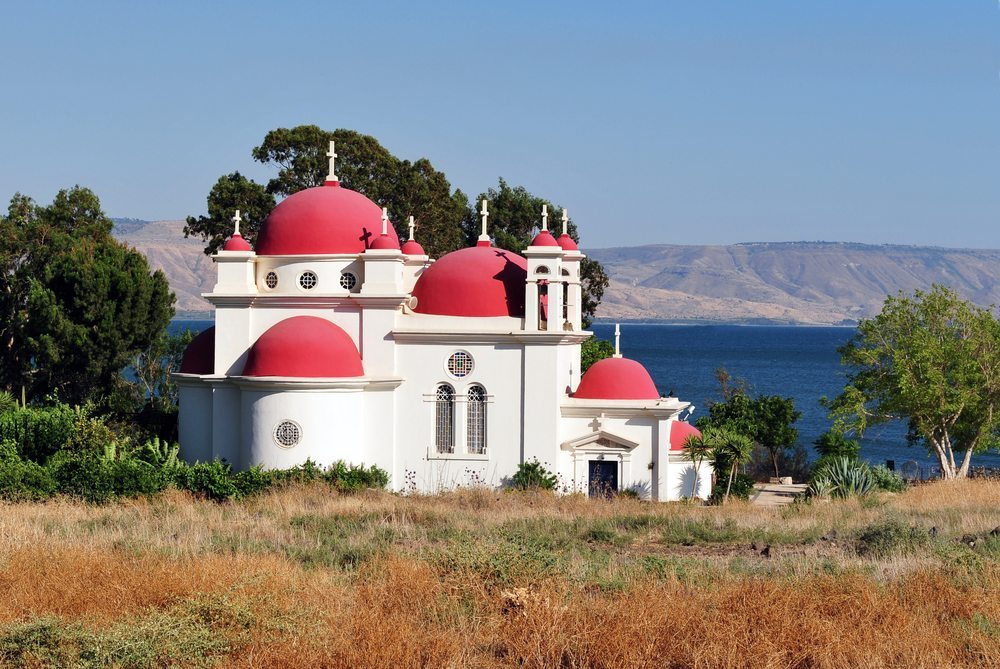
The Greek Orthodox church of the Twelve Apostles, located on the northwestern shore of the Sea of Galilee on the site of ancient Capernaum.
Where did Jesus live during the period of his ministry? Was he an itinerant preacher or did he have a permanent home? The Gospels record that after leaving the wilderness of Judah where he had been baptized by John the Baptist, Jesus returned to his childhood home of Nazareth up north in the fertile rolling hills of the Lower Galilee. Luke describes the formal beginning of his earthly ministry as follows:
Then Jesus, filled with the power of the Spirit, returned to Galilee, and a report about him spread through all the surrounding country. He began to teach in their synagogues and was praised by everyone. (Luke 4:14-15)
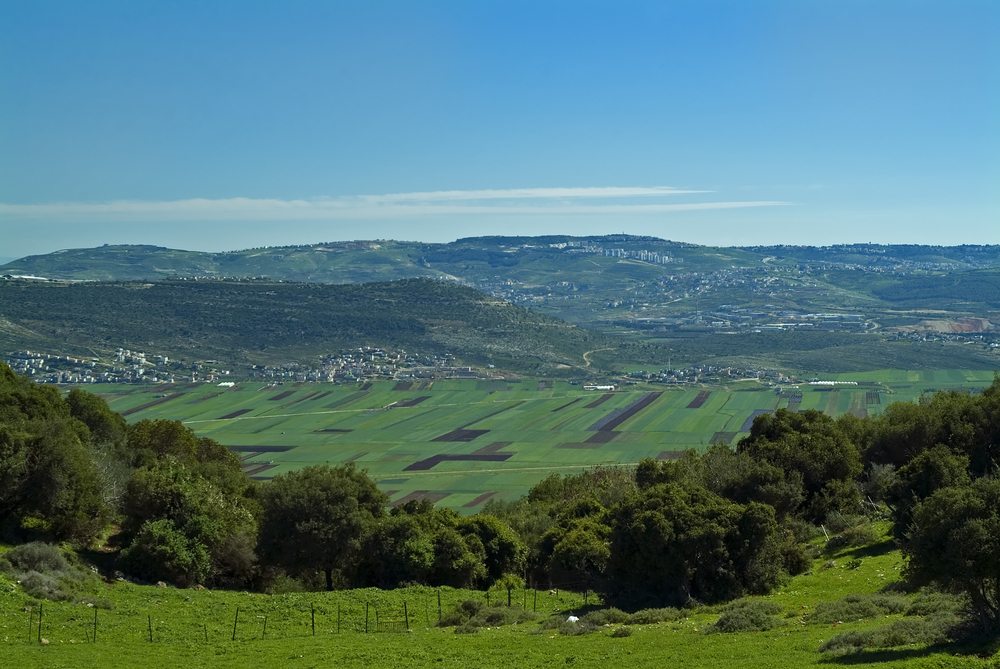
The fertile Bet Netofa Valley, a few miles north of Jesus’ hometown of Nazareth, which can be seen on the hilltop in the distance.
But Jesus soon realized that his hometown of Nazareth was not receptive to his teachings, so he relocated to the fishing village of Capernaum on the northern shores of the Sea of Galilee. Capernaum (Καπερναούμ) is the Greek transliteration of two Hebrew words, Kefar Nahum (כפר נחום), which means “the village of Nahum”, presumably the patronymic of its founder. Today, a 40 mile hiking trail known as the Jesus Trail traces the route Jesus might have walked from Nazareth to Capernaum. Over the next few years, Capernaum would become Jesus’ headquarters. Although he moved around the region quite a bit, Jesus always returned to Capernaum. He preached in the Capernaum synagogue which was built by a Roman centurion (Luke 7:5). He healed the mother-in-law of Peter in the latter’s house in Capernaum (Matthew 8:14). In Capernaum he befriended a tax-collector named Matthew (also known as Levi) who became one of inner circle of twelve disciples (Mark 2:15). The Gospel of Matthew even calls Capernaum τὴν ἰδίαν πόλιν, “his own town” (Matthew 9:1). The question I would like to examine today is: why did Jesus make Capernaum his base of operations during the period of his ministry?
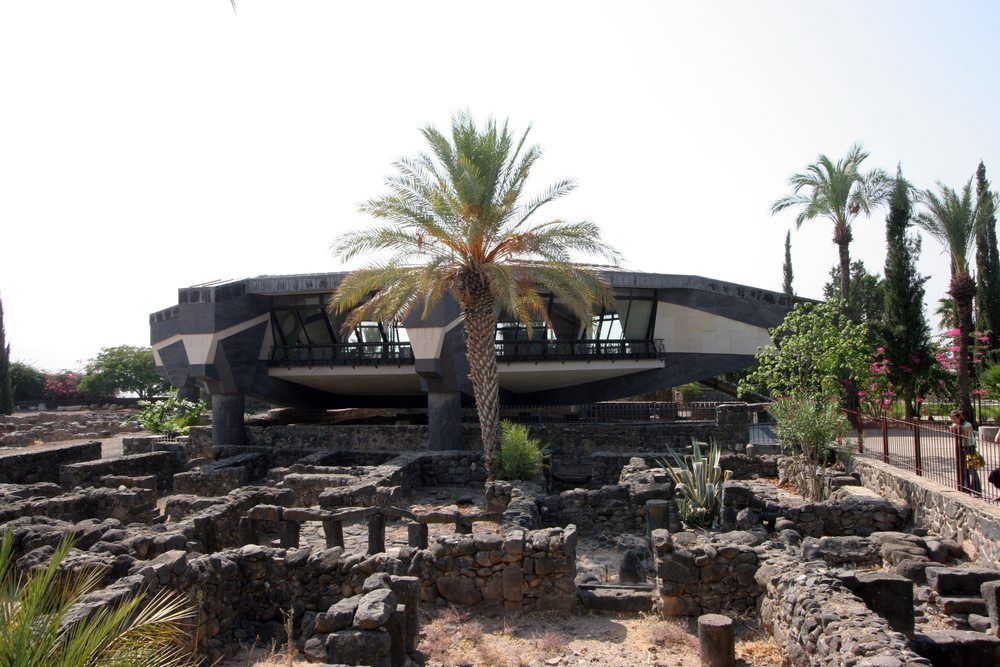
Residential homes from the 1st century at Capernaum. The modern structure in the background in a Roman Catholic church built above the traditional site of the house of Peter, where Jesus healed many people (Matthew 8:14-16).
One reason that Jesus chose Capernaum is that it was a frontier town, located close to the border between two administrative districts. A bit of historical background is needed to understand this point. In most cases, the Romans preferred to rule far flung provinces in the east by means of vassal kings rather than appointing one of their own. In the eyes of the Romans, Herod the Great was an excellent vassal. He was exceeedingly loyal to the emperor, efficiently gathered taxes, kept the population of his province subordinate, and fostered Greco-Roman culture. After the death of Herod in 4 BCE, the expansive territory over which he had ruled for 34 years was divided up among three of his sons: Archelaus, Antipas and Philip. The first century Jewish historian Josephus describes the division as follows:
And now Herod altered his testament upon the alteration of his mind; for he appointed Antipas, to whom he had before left the kingdom, to be tetrarch of Galilee and Perea, and granted the kingdom to Archelaus. He also gave Gaulonitis, and Trachonitis, and Paneas to Philip, who was his son. (Josephus, Antiquities 17.8)
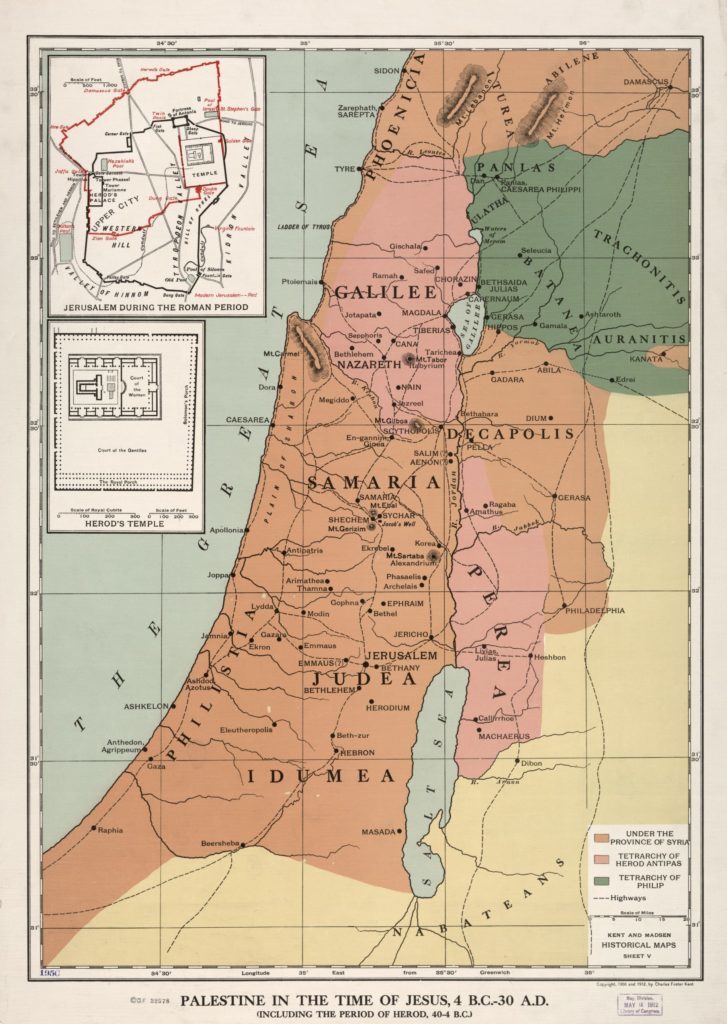
At the time of Jesus’ ministry, Capernaum was located very close to the border between the territories of Antipas (pink) and Philip (green).
In other words, the majority of Herod’s former kingdom (the choice hilly regions of Judea, Samaria and Idumea) was entrusted to Archelaus. This situation lasted for a mere ten years until 6 CE, when the corrupt Archelaus was replaced by a direct Roman governor called a prefect. Later, these governors from Rome were renamed procurators. The most famous of the prefects was the notorious Pontius Pilate, who held the position from 26-36 CE .

A dedicatory inscription mentioning Pontius Pilate, discovered by archaeologists at Caesaera Maritima in the 1961. This is the only artifact ever found that contains Pilate’s name. Despite the pivotal role he plays in the Gospels, not very much is known about Pilate. Other than the New Testament, only Philo and Josephus briefly discuss his cruelty.
What about the rest of Herod’s kingdom? Antipas and Philip, the other two sons, continued to hold onto their outlying territories for three decades until the late 30s. This is precisely the period during which Jesus was active in this very region. Antipas was in charge of Galilee and Perea (4 BCE – 39 CE), while Philip was the ruler of the northeastern regions of the Golan and eastward: Gaulanitis, Trachonitis, Ituraea and Auranitis (4 BCE – 34 CE).
All this political background is highly relevant for the question I posed at the outset of this post. Being in Capernaum, on the border between the Galilee and the Golan, allowed Jesus to avoid trouble with the law, especially as his revolutionary message increasingly began to challenge the establishment. If he sensed that the authorities in one district were looking for him, he could quickly cross the border over into the neighboring district to avoid arrest.
A second reason is that Capernaum appealed to Jesus is that it allowed him to come into contact with a broad range of people, both Jews and Gentiles. This sociological diversity was a cornerstone of his ministry. And this too was due to the geographical position of Capernaum. The village was located right along one of the major international highways of the Ancient Near East: the coastal road, which connected Egypt to Mesopotamia. This road began in the area of the Nile Delta and made its way north along the Mediterranean Coastal Plain. Rather than hugging the strip adjacent to the sea which is composed of sand dunes, the road was situated several miles inland on firmer ground. It circumvented the Yarkon River north of Jaffa and continued through the thickly forested Sharon. At Mount Carmel it turned inland, cutting through Nahal Iron (Wadi Ara), passed beneath the great city of Megiddo, and crossed the Jezreel Valley until it reached the Sea of Galilee. It was here that the highway skirted the modest village of Capernaum. We might imagine that Capernaum was a “pit-stop” offering shelter and food to those traveling from Damascus to the Mediterranean Sea and further afield. Maybe this is the reason Capernaum had so many “tax collectors” (τελῶναι). These hated employees of the Roman government would sit at a “tax booth” (τελώνιον), a toll station by the side of the road. Travelers on the international route had to stop at Capernaum to pay this toll.
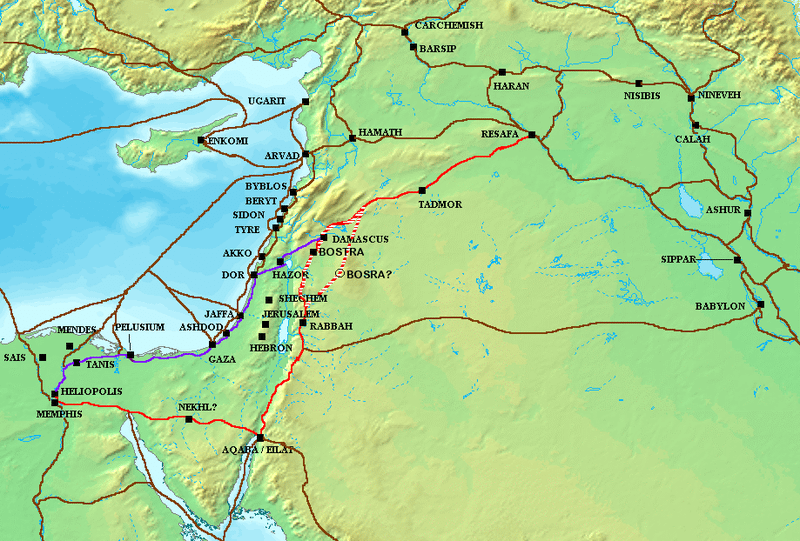
The purple line represents the international coastal road, which in modern literature is usually called the Way of the Sea or the Via Maris.
Most scholars refer to this major international highway as the Way of the Sea. The importance of the Way of the Sea cannot be overstated. To a large extent, the importance of the Holy Land to the great empires of the Ancient Near East was not due to the physical attributes of the land itself, but rather to its strategic position as a linchpin linking Africa, Asia and Europe. The Way of the Sea was the main artery allowing for efficient travel across this linchpin. But was it really called the Way of the Sea? Fascinatingly, no, according to the late Anson F. Rainey, one of the foremost biblical geographers of the 20th century and a co-author of the superb biblical atlas The Sacred Bridge (Carta, 2014). The term “Way of the Sea” (Hebrew Derekh haYam דרך הים) appears only once in the Hebrew Bible, in the following verse:
But there will be no gloom for those who were in anguish. In the former time he brought into contempt the land of Zebulun and the land of Naphtali, but in the latter time he will make glorious the way of the sea, the land beyond the Jordan, Galilee of the nations. (Isaiah 8:23[9:1])
כִּי לֹא מוּעָף לַאֲשֶׁר מוּצָק לָהּ כָּעֵת הָרִאשׁוֹן הֵקַל אַרְצָה זְבֻלוּן וְאַרְצָה נַפְתָּלִי וְהָאַחֲרוֹן הִכְבִּיד-דֶּרֶךְ הַיָּם עֵבֶר הַיַּרְדֵּן, גְּלִיל הַגּוֹיִם
According to Rainey, when taken in context, the “Way of the Sea” originally referred to a local road across the Upper Galilee linking Caesarea Philippi with Tyre. The Latin translation of the Bible rendered this as Via Maris, and from here it was cherry-picked by later commentators and historical geographers who applied the term to the great international coastal highway. Rainey’s vexing conclusion is that:
The irony is that the major line of communication from Egypt to Mesopotamia via the coastal plain of Canaan/Israel has no name in the ancient sources. (Sacred Bridge, 251)
Despite this terminological complication, it is noteworthy that the Gospel of Matthew cites this very verse when explaining Jesus’ decision to relocate to Capernaum.
He left Nazareth and made his home in Capernaum by the sea, in the territory of Zebulun and Naphtali, so that what had been spoken through the prophet Isaiah might be fulfilled: “Land of Zebulun, land of Naphtali, on the way of the sea, across the Jordan, Galilee of the Gentiles…” (Matthew 4:13-15)
The citation of Isaiah 9:1, the seventh of Matthew fulfillment quotations, is very suitable here. It illustrates well the universal aspect of Jesus’ ministry which Matthew wishes to emphasize. Due to his position on the Way of the Sea, Jesus was no longer landlocked in the exclusively “Jewish Galilee” of Nazareth. He was now a member of the cosmopolitan “Gentile Galilee” of Capernaum where he had access to a much broader audience. This pro-Gentile theme is seen elsewhere in Matthew, for example in John the Baptist’s striking critique of the ethnic exceptionalism of the Pharisees and Sadducees: ” Do not presume to say to yourselves: ‘We have Abraham as our ancestor’ for I tell you God is able from these stones (אבנים) to raise up children (בנים) to Abraham” (Matthew 3:9). Admittedly, Jesus does teach an exclusivistic, anti-Gentile message, for example when he instructs his disciples: “Go nowhere among the Gentiles and enter no town of the Samaritans, but go to the lost sheep of the house of Israel” (Matthew 10:5-6). Ultimately, however, the universal mission which transcends the small world of Judaism is really the main thrust of Jesus’ ministry, as we clearly see in the final words of the Gospel of Matthew: “Go therefore and make disciples of all nations, baptizing them in the name of the Father and of the Son and of the Holy Spirit” (Matthew 28:19).





To the Jew first and then to the Gentile. Holy Spirit continues teaching through Apostle Paul. As we should follow, to the Jew first, then to the rest of the World people groups.
A very interesting true post, this is so great about Jesus.
Thank you! I have just become aware of your online studies and was not disappointed. As someone who tends to be a visual learner, the maps and pictures really helped to drive your points home for me. Shalom.
A very informative and interesting blog. I have also been to the Galilee and Capernaum during the four tours of Israel I have taken.
Very interesting viewpoint, and, as Rob said above, new information for me. Fascinating perspective!
Science annihilates distance, and old technology populates roads. Interesting that the extensive caravanserai in Akko, in the Bay of Haifa, so close in distance but years in the future, was apparently not even inchoate, and the geographical possibility irrelevant, in the time of Jesus.
Mysterious are the ways of the Lord!
I enjoyed reading your post Jonathan. Very interesting information about Jesus’ location during his ministry. I am looking forward to be a part of this bible study group.
I would like to receive this information on a regular basis. Thank you for the opportunity!
Loretta
thanks for the insight. I love Biblical history and learning in general
I enjoyed this teaching article; very authoritatively researched. I learned much. Thank you and God bless your teaching.
A very interesting post with information I did not know before. I have been to Capernaum and Galilee a few times.